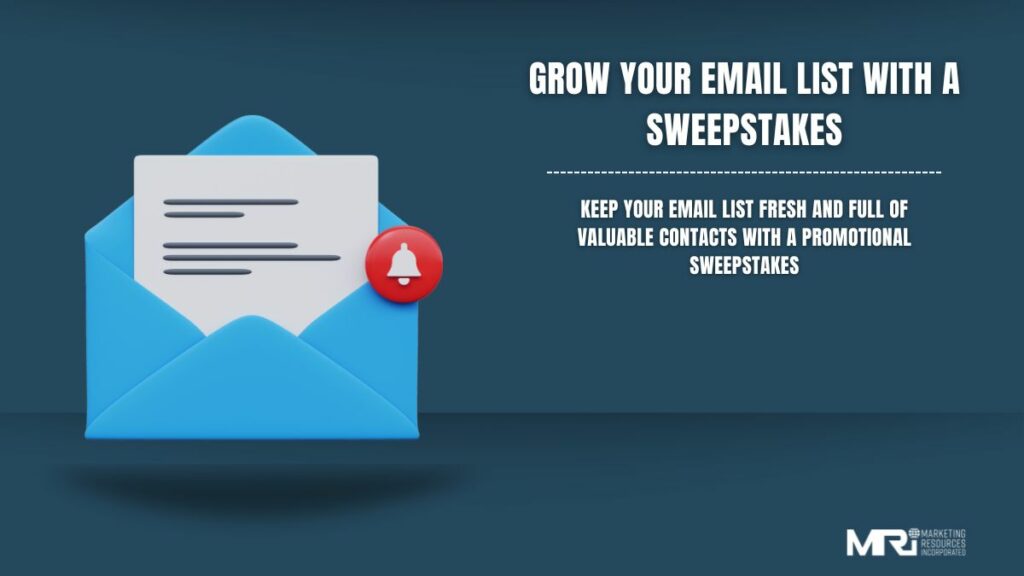Email is a particularly effective marketing channel utilized by almost 90% of all marketers in 2021 (Oberlo.com). A tool to share your brand message, connect with consumers, nurture leads and convert them into customers, email is every marketer’s secret weapon. Their email database is the engine keeping everything running.
Without a constant flow of inbound leads generating daily on their own, your email database can get a little stale. In fact, the value of your email marketing list depreciates over time. Contacts change their information, people leave their jobs, and opt out of emails, among other things, meaning your brand can no longer connect with them. Yikes!
Keep things current and grow your email database with an effective and engaging sweepstakes promotional campaign. Capture users’ contact info to further engage with them via email.
Using Sweepstakes to Grow Your Email List
Oftentimes, brands choose to run a promotional sweepstakes campaign due to the sheer volume of data they can collect for a brand.
The beauty of a promotional sweepstakes lies in its versatility. Your brand can customize your campaign to meet any number of business or marketing objectives. However, do keep in mind that just because a sweepstakes can help your brand achieve several different goals, you shouldn’t try to accomplish them all at once. Kind of like growing a mullet, just because you can, doesn’t mean you should. When determining your sweepstakes campaign’s goals, be as specific and purpose-driven as possible. When choosing to run a sweepstake to grow your email list, focus solely on that as your primary objective.
The data gathered from every sweepstakes will give you the information you need to make an even more successful sweepstakes next time.
How to Collect as Many Email Addresses as Possible With Your Promotional Campaign
Just because a sweepstakes campaign makes for a highly effective lead magnet, doesn’t necessarily mean they run themselves. Instead, follow our advice below to maximize the number of emails your brand collects. For even more helpful advice on how to optimize your campaigns, check out some of our work here.
- Keep forms short and sweet- Users do not want to spend a significant amount of time filling out forms. Especially with over half of all web searches being mobile as of 2021, keep your entry forms as short as you can and ask only the information your brand absolutely needs (email address obviously being one of them!)
- Share on social media– A great tactic to spread the word about your campaign in general, boosting your promotion on social media is a quick, usually free, and easy way to increase the number of submissions and emails your brand collects.
- Print on-pack messages– Your product’s packaging is the perfect place to advertise your own campaigns! Optimize that valuable space with on-pack promotional details or even unique codes or images to scan via OCR.
- Hire an expert– At MRi, we have decades of experience facilitating successful campaigns and growing client email lists. Save yourself the time and hassle of executing a campaign and hire a trusted partner!
Of course, these are only a few options for boosting your campaign. Explore all of our insights for even more tips and tricks!
Following Privacy Laws with Data Collected from Your Sweepstakes
The data collected from a sweepstakes can be a gold mine for your brand. That is, only if you follow data privacy laws and consumer protection guidance. Otherwise, not only is that data of no use to you (at least from a marketing perspective,) but you may even face fines and legal action if you do use it.
Before trying to grow your email database, ensure your brand follows the below tips and stays legally compliant.
1. Users must actively opt-in
While auto-filling forms make the process faster and more convenient, oftentimes increasing conversion rates, do not auto-fill an opt-in form! Your website visitors must actively opt-in to receive your communication on their own. It must be a conscious action on their part.
Relatively new legislation in the EU makes this a legal requirement for website visitors across the pond. So, while this may not have any legal implications in the United States just yet, be sure to follow this best practice anyway, as it may soon. Plus, any EU residents traveling or visiting from abroad are still protected by this law, even when visiting an American site.
Be clear, concise, and direct with your messaging, and allow users to “double opt-in” to ensure your brand remains compliant. A “double opt-in” is simply when users need to confirm their email address before being added to your email list.
2. Disclose your brand’s intent
When asking users for their personal contact information, it only makes sense to explain how you intend to use it. Will you call them? When? What will you call them for? When will you email them? What will those emails be about?
Don’t leave any room for interpretation here– be as specific as possible. Your brand must include disclosures for any and all communications using the data you’ve gathered. If you intended to reach out to these contacts down the road to announce a new product or service, you’ll need to let them know when you collect their data.
There’s no need to be a wizard here. You don’t need to accurately predict every move your email marketing team will make. Rather, some language along the lines of “your information may be used to announce future product launches to you via email” will suffice.
3. Display an accurate Privacy Policy on your website
Tell your consumers exactly how you collect their data and what your brand will do with it. This not only creates transparency and allows your visitors to trust your brand, but protects your brand from a number of federal and state laws that require a privacy policy in specific situations.
There is no federal law stating “all websites must have a visible privacy policy,” However, there are several laws that protect and regulate particular groups and circumstances. For example, children have more privacy rights online than adults, brands simply cannot use a child’s data and info like they can a legal adult. Similarly, financial and medical information is protected by various laws. Your brand will therefore want a privacy policy as a layer of protection, just in case.
Your Privacy Policy should include:
- The type of information you collect from visitors and how you collect it (cookies, forms, tags?)
- What your brand does with the information it collects. Do you offer personal suggestions or advertisements from it? Do you study it? How does it benefit your brand?
- How does your brand protect this info? From Hackers? From other companies?
- Who, if anyone, do you share the info with? Why? Do they pay for it? What do they do with it?
Make sure your privacy policy is easily accessible somewhere obvious on the site, and rest easy knowing your brand is protected online.
Examples of Appropriate Email Opt-In Language:
Below are just a few hypothetical examples of language your brand can use to help your write you own email opt-in disclaimers.
- A fashion retailer may want to include language such as “sign me up for monthly emails with the latest fashion trends, outfit suggestions, and store discounts” as opposed to “sign me up for emails.” This language is far more specific and while it doesn’t say exactly what the content of future emails will consist of, users get a great idea of what to expect.
- A financial brand may want to include the following language in their opt-in disclosure, “yes, I consent to receive emails about my accounts, future deals, and personalized investment advice.”
However your brand chooses to write your email opt-in language, try to make sure your users are never surprised by the communications they receive from you.
Does Your Brand Need Help Growing Your Email List?
At MRi, we have decades of experience helping brands identify their purpose and execute successful campaigns through our unique IDEA approach. No matter where you are in your promotional campaign planning, contact us today to run your brand’s next successful campaign!






